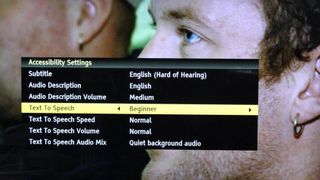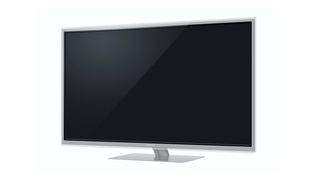Will Apple's iTV feature voice recognition and a speaking program guide?
Talking TVs could change the way we interact with our electronics

Your iPhone might be busily talking away to you and soon almost all gadgets will be able to understand some spoken instructions, but will the rumoured Apple iTV talk back to you?
Panasonic and British technology company TVonics have developed products that can physically talk, and which could change the way we all interact with our electronics.
The 'talking TVs' from Panasonic and TVonics' DTR-HD500 Freeview HD set-top box go against the trend somewhat.
New TVs from both Samsung and LG are equipped with voice recognition technology that takes spoken commands in place of those from a remote control. On Samsung's ES8000 Series of LED TVs it's impressive stuff.
Completely revolutionising the long criticised web browser experience on a TV, simple search terms can be barked at the Samsung TV as well as navigation controls and set phrases to operate other functions.
It's even subtler than it sounds, with a second mic buried in a remote control so that instructions don't need to be yelled. The gesture control system, meanwhile, is less successful.
Talking television
You've probably had a go at voice control on the Xbox 360's Kinect, too, but Panasonic's 'talking televisions' - in essence its entire 2012 output - are more interesting in that they're all about explanation.
Get daily insight, inspiration and deals in your inbox
Get the hottest deals available in your inbox plus news, reviews, opinion, analysis and more from the TechRadar team.
Audio Description services, which describe what's happening onscreen for blind and partially sighted people, were pioneered by Panasonic, but this is another step forward.
Developed in conjunction with the Royal National Institute of Blind People (RNIB) in the UK, this 'Voice Guidance' software attempts to solve a major accessibility problem in the digital TV age: how to browse complex TV schedules and set recordings.
It works by announcing onscreen information using synthetic speech and provides clear instructions on how to navigate the TV menu. During our test we found it incredibly straightforward: after you've engaged Voice Guidance in the Sound menus, and chosen the volume, user level (beginner or expert - the former using very comprehensive explanations) and speed, the TV suddenly becomes exceptionally user-friendly.
Change the Freeview channel and a woman's voice announces 'DVB, ITV1, The Jeremy Kyle Show, 09:25- 10:30, subtitles', with each channel change, while there is full guidance for all other aspects of the EPG (searching, changing to Freesat or analogue channels, selecting by genre), changing inputs, and volume.

Leen Petre, principal manager, Media and Culture at RNIB says that the TVs have been very well received by blind and partially sighted people. "People I've spoken to are those that generally struggle with technology, and what they like is that it's all-in-one. Having separate boxes and having to know whether you're on HDMI 1 or HDMI 4 - people haven't got to worry about that," she says, adding that she hopes the other big TV companies will soon follow Panasonic's example.
Accessibility for all?
Is this new tech purely for those with sight difficulties? Not at all, says Mark Vasey, senior manager at the Panasonic IPTV & DTV Solution Centre in the UK.
"Initially our intention was to implement the functionality for blind and partially sighted users, allowing them to access the TV and discover and select content in the same way a fully sighted user could," he says.
"However, we also believe text-to-speech is extremely useful for non-technical users, who are not so familiar with more complex TV functionality - such as the EPG and management of recordings. We believe that the spoken instructions for navigation and operation will be very beneficial to these users in understanding how the features work and what they offer."
Petre agrees: "There are so many different options and menus on modern TVs and this technology is good for people - not just blind and partially sighted people - that aren't familiar with using a menu-driven interface, which can be bewildering. Put it in Beginner mode and the Panasonic TV doesn't just tell you what's on your screen, but what to do next."
Voice guidance vs voice activation
Panasonic clearly believes that blind and partially sighted users should have the same access to our TVs as sighted users without paying an additional premium. However, the technology it's come up with will help a lot of users get to grips with the digital and smart TV functions.
"It's a natural next step to consider how text-to-speech and voice activation could be combined to provide a significant step forward in the overall user experience of what are becoming increasingly complex products," says Vasey, adding that its work with the RNIB highlighted the need to consider how to improve navigation of its TVs in general, and not just for blind or partially sighted users.

"Anything that reliably introduces more interactivity more directly, and takes away the need to navigate menus or use a whole series of buttons on remote controls, is going to be beneficial for blind and partially sighted people, but only if it's combined with voice output of what appears on the screen," says Petre, who's cautious about embracing a technology that hasn't so far been thought through in terms of accessibility for all.
"Some people seem to think that the next big thing is voice control, and that we won't need voice guidance, but it's only a substitute for pressing buttons - it still doesn't allow you to know what appears on your screen. We need a combination of the two, but voice activation has massive potential and the RNIB would be very keen to explore how the two technologies can be combined."
Petre adds that much of the innovation around remote controls has accessibility limitations, and that both wand-style remotes and those with touchscreens actually make things more difficult for blind and partially sighted people.
Jamie is a freelance tech, travel and space journalist based in the UK. He’s been writing regularly for Techradar since it was launched in 2008 and also writes regularly for Forbes, The Telegraph, the South China Morning Post, Sky & Telescope and the Sky At Night magazine as well as other Future titles T3, Digital Camera World, All About Space and Space.com. He also edits two of his own websites, TravGear.com and WhenIsTheNextEclipse.com that reflect his obsession with travel gear and solar eclipse travel. He is the author of A Stargazing Program For Beginners (Springer, 2015),
Most Popular



